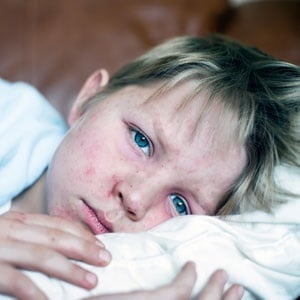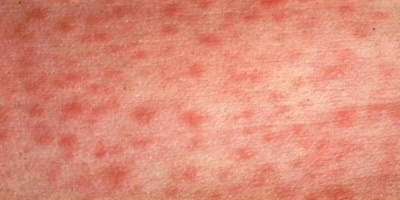
Alternative name: rubella
German measles is a common infectious disease of childhood.
It usually affects the skin, causing a typical rash, and also involves the lymph nodes. German measles is caused by a virus infection. This isn’t the same virus that causes measles.
The Rubella virus is a member of the Toga virus family. This virus, which usually causes a rather mild illness, circulates widely in South Africa and internationally each year.
Although German measles is almost always a mild disease in children, the danger with this infection is that it may occur in pregnant women and possibly cause what is known as congenital rubella syndrome in babies.
The illness is called German measles because German physicians wrote the first clear description of it in 1760. Rubella vaccines that prevent this illness first became available in 1969.
According to the World Health Organization (WHO), rubella is the leading vaccine-preventable cause of birth defects all over the world.
Who can get German measles?
German measles spreads when people breathe in small droplets of fluid carrying the virus – for example, when a person who has German measles sneezes or coughs. The illness is also spread by infected people eating from the same utensils or drinking from a cup or glass shared with someone else.
Single cases of German measles can occur at any time, and every so often there are outbreaks involving schools or places where large groups of children gather. Adults (usually teachers and parents) may also be infected during these outbreaks.
Rubella follows a seasonal pattern, with activity increasing in the spring. In South Africa, about 90% of people will have had rubella by adulthood.
In this country, doctors are required to send blood samples from patients presenting with rubella symptoms to the National Institute for Communicable Diseases (NICD). According to a 2017 fact sheet released by the Institute, a total of 1,752 (36.5%) samples tested positive for rubella antibodies from all nine provinces.
The provincial breakdown was as follows:
- Eastern Cape: 78
- Free State: 25
- Gauteng: 408
- KwaZulu-Natal: 492
- Limpopo: 112
- Mpumalanga: 92
- North West: 103
- Northern Cape: 132
- Western Cape: 208
This represents more than double the number of rubella cases detected in 2016, when 817 (28.8%) samples contained rubella antibodies.
It’s estimated that about 660 cases of congenital rubella syndrome (CRS) occur in South Africa every year. Rubella in pregnant women can cause congenital rubella syndrome with the possibility of extremely serious consequences for the developing baby.
Babies who are infected with rubella before birth are at risk of growth problems, mental retardation, defects of the heart and eyes, deafness and liver, spleen and bone-marrow problems. This is largely preventable through vaccination.
Symptoms of German measles
It’s quite possible and not uncommon to have German measles without any symptoms at all. It’s almost always a relatively mild disease, especially in children.
Rubella infection usually begins with 1-2 days of mild fever (37.5-37.8 degrees Celsius), followed by the appearance of swollen and tender lymph nodes (usually behind the neck or behind the ears).
A rash consisting of slightly raised, pinkish or light-red spots (see picture below) then starts to appear on the face and spreads down to the chest, back and limbs. As the rash spreads downwards, it usually clears up on the face. The spots of the rash may join up and merge, causing evenly coloured patches. The rash can itch and usually lasts for about 3 days.
It may be difficult to distinguish the rash of rubella from some of the other rash diseases of childhood. These include measles, roseola (baby measles), parvovirus ("slapped cheek disease") and enterovirus infections. A strong clue that you or your child has rubella is the presence of enlarged lymph nodes behind the ears and the back of the neck. A mild fever is usual, and children with rubella may complain about a sore throat and conjunctivitis (red eyes).
Sometimes aching joints and even swelling of the joints, warmth and redness of the joints can occur after a few days of having the illness. This is much more common in adults, especially women. Any joint may be affected, but most often it is the finger joints and knees. Sometimes joint pain will last for more than two weeks.
The most serious problem associated with rubella is infection during pregnancy, which puts the developing baby at serious risk of the congenital rubella syndrome. Other complications such as encephalitis (acute inflammation of the brain) and blood disorders are extremely rare.
What causes German measles?
German measles is caused by the rubella virus. There’s only one strain of the virus, which regularly spreads from country to country.
The rubella virus only infects humans and so can only spread from one person to another. It passes from person to person by means of tiny drops of fluid from the nose and throat of an infected person who is sneezing and coughing.
People who have rubella are most contagious from one week before to one week after the rash appears. Someone who is infected, but who has no symptoms, can still spread the virus. This places pregnant women who have not had rubella as a child or who have not been vaccinated against rubella at particular risk. Babies who are infected with rubella before birth are at risk of growth problems, mental retardation, defects of the heart and eyes, deafness and liver, spleen and bone-marrow problems.
Infants with congenital rubella syndrome can shed the virus in urine and fluid from the nose and throat for a year or more, and may pass the virus to people who haven’t been vaccinated against rubella.
Risk factors for German measles
Any person who hasn’t had German measles before, or who hasn’t been vaccinated, is vulnerable to rubella infection.
The major risk of rubella is that it may be acquired in pregnancy. Rubella isn’t a significant risk for a pregnant woman herself, but the infection puts her developing baby at risk.
The risk to the baby is only during the early stages of its development, especially during the first 18 weeks of pregnancy when the major organs (heart, liver and brain) are developing. After the first 18 weeks of pregnancy, rubella infection in pregnancy isn’t usually a major cause for concern.
The consequence of rubella infection in early pregnancy is that the baby is highly likely to be born with physical and mental abnormalities, which include:
- Low birth weight and having an enlarged liver and spleen.
- Deafness.
- Mental retardation.
- Abnormalities of the heart valves or major arteries taking blood from the heart to the rest of the body.
- Eye defects such as cataracts, which sometimes result in blindness.
The combination of these defects is called ‘congenital rubella syndrome’ (CRS). There’s an 80% risk that one or more features of this syndrome will occur if the mother contracts the infection in the early stages of pregnancy (the first 18 weeks).
The most consistent feature of CRS is deafness due to nerve damage. Infection before 12 weeks of pregnancy carries the greatest risk of heart, eye and brain abnormalities in addition to deafness, whereas infection between 13 and 18 weeks can result in deafness alone.
Even with the very sophisticated methods that are now available to investigate a baby who is still in the womb, it remains difficult to diagnose whether, and how severely, a baby has been affected before it’s born. For this reason, the parents and doctor involved have to base a decision about possibly terminating the pregnancy on information about the probable outcome for the baby, which is based on the experience of many previous cases.
Course and prognosis of German measles
It takes anything from 14 to 23 days, with an average incubation period of 16 to 18 days, for the symptoms of German measles to appear in an infected person.
A day or two of feeling unwell and a mild fever is followed by the appearance of the rash. The rash disappears after about three days. The lymph glands in the neck enlarge before the rash appears and will remain enlarged for a week or more after the rash has disappeared. Uncomplicated rubella is a short-lived illness. The antibodies produced after a rubella infection also provide protection against future infections, but reinfection does sometimes occur.
Note that a person infected with rubella is infectious up to seven days before and at least four days after the rash has appeared.
How is German measles diagnosed?
Many doctors will make a diagnosis of German measles based on the clinical appearance of the child, thus avoiding a blood test. However, suspected rubella in a pregnant woman must be confirmed by a blood test sent to a laboratory. This is essential because of the serious implications of the diagnosis.
Of importance for pregnant women is that rubella can be easily confused with parvovirus infection, as the rash is similar. The blood tests will help to distinguish between the two infections.
Parvovirus can also affect the foetus, but the effects are quite different and management by the obstetrician will take a very different course.
How is German measles treated?
There’s no specific treatment available for German measles. Unless there are complications, which is extremely rare, rubella will get better on its own.
A child with rubella can be treated at home with paracetamol, given as needed for the fever or any discomfort. Consult your GP about medication if joint symptoms occur. Serious or persistent inflammation of joints after rubella infection may warrant a specialist consultation. Anti-inflammatory drugs or cortisone may be necessary.
When to call a doctor
During an outbreak of German measles, when many children in your community are infected, it may be easy to diagnose rubella yourself. But it’s likely that you’ll still want confirmation by your GP.
If your child develops a sudden illness with a rash, it’s advisable to see your GP, as there are a number of possible causes.Many children with rubella only feel mildly ill, and should simply have a few quiet days at home. All that is required is to keep an eye out for any sign of complications (e.g. aching joints, bleeding problems), as any of these will require a visit to the GP for management.
Respond immediately to the warning signs of the rare complication of encephalitis (inflammation of the brain). Symptoms include headache, vomiting, stiff neck, drowsiness or convulsions. If your GP isn’t available, take your child to a hospital emergency unit.
How can German measles be prevented?
A child with German measles is infectious from about five days before to five days after the rash has appeared.
There’s nothing that can be done about exposure of other people to the infection before the rubella becomes apparent. However, you should still try to limit your child’s contact with other people once you know the diagnosis. The main danger is that a pregnant woman may be put at risk. Staying home from school until the five days are up is an appropriate measure.
Rubella vaccination forms part of the routine vaccination schedule provided by the state in South Africa. It’s given with the MMR vaccination at 15 months, with a booster given between 4 and 6 years. The MMR vaccination is safe and there are no longer any concerns about any possible link with autism.
It’s important to prevent epidemics of this illness, especially because of the danger posed to pregnant women. In South Africa, there are still babies born with congenital rubella syndrome each year. This is preventable.
Due to the very serious risks of rubella in pregnancy, all women who are planning a pregnancy should have a blood test to see whether they’re immune to rubella. If not, they should be vaccinated against rubella before falling pregnant.
The rubella vaccine should not be given to a pregnant woman, as it is a live attenuated vaccine preparation that may cause harm to the developing baby. Of note is that there has never been any proof of a baby being affected in this way by accidental administration of the vaccine during pregnancy. Therefore, accidental administration of rubella vaccine during pregnancy isn’t a cause for too much concern. It definitely is NOT regarded as a reason to terminate the pregnancy.
Natural infection with rubella virus gives life-long immunity and reinfection is very rare. Unfortunately, immunity after rubella vaccination isn’t quite as strong and may lessen over time. For this reason, reinfection with the rubella virus may occasionally occur in previously vaccinated individuals.
Reinfection is usually a much milder disease. Reinfection in the early weeks of pregnancy do pose a risk to the foetus, but the risk is only about 10% of the risk of a first or "primary" infection.
Reviewed by paediatrician Prof Eugene Weinberg. MBChB; FCP (SA); PAED (SA). April 2018.




 Publications
Publications
 Partners
Partners













